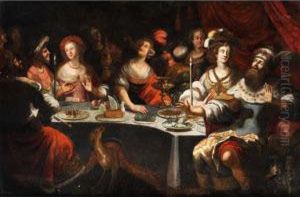Bartholomaus Strobl Paintings
Bartholomäus Strobel was a significant figure in Baroque art, born in 1591 in Breslau, Silesia (now Wrocław, Poland). His life and career were deeply influenced by the turbulent times in which he lived, marked by the Thirty Years' War and the shifting political landscapes of Central Europe. Strobel's artistic journey began in his hometown, but his ambition and quest for artistic development led him across Europe, including lengthy stays in Prague and Danzig (now Gdańsk, Poland), where he found patronage and recognition.
Strobel's work is characterized by its intricate detail, dramatic use of light, and often, complex religious and allegorical themes. He was particularly noted for his large-scale paintings, which included altarpieces, portraits, and historical scenes. One of his most renowned works is the 'Feast of Herod with the Beheading of St. John the Baptist,' a monumental canvas that showcases his mastery of composition and his ability to weave intricate narratives into his paintings.
Throughout his career, Strobel received commissions from some of the most prominent figures of his time, including members of the Habsburg dynasty and the Catholic Church, reflecting his reputation as one of the leading artists of the Baroque period in Central Europe. Despite the fame he achieved during his lifetime, Strobel's work fell into relative obscurity after his death in 1649. It was not until centuries later that art historians began to re-evaluate his contributions to European art, recognizing him as a master of Baroque painting whose works offer a vivid window into the cultural and political milieu of 17th-century Europe.
